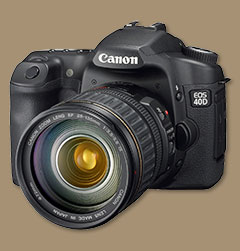 Tight Canon
Tight Canon
At last, the camera shows up
(Born August 20, 2007)
Remember the EOS 20D? Great camera with great 8MP images.
A while later the EOS 400D showed up, also Called the Rebel XTi, it had Canon's new vibrating sensor dust shake cover, plus a 10MP image chip and more.
Then A Big Announcement was pre-announced. Stocks of 20Ds evaporated from store shelves. Rumors buzzed.
When the shoe dropped, the EOS 30D landed. Erm, an 8MP camera with none of the swoopy new features of the 400D. A mood of "What the @#$%^&" washed over the minds of Canon's enthusiasts.
The new 30D was fine, but public expectation was for what showed up just now, the EOS 40D. And gestation was only 16 months.
At Last
The new 40D is the 400D on Camera Growth Hormone.
It has a lovely 3" monitor, 10.1 MP image chip (CMOS made by Canon in their own back room), the clever Live View system with 5X and 10X supercritical magnification, a new focus system, the latest Digic III processor, 14-bit A>D RAW pixel capture, sRAW capture, better noise reduction (seen in the EOS-1 D Mark III at PMA) and dust cleansing at the chip without probes of intervention.
Whew.
And the best news of all: Nice Price. $1300 plus lens.
Large frame image size is the same as the 400D, 3888 x 2592 pixels. But this body is big, easy on the hands and solid as a rock, but made out of magnesium.
Features
Live View is a stunning Canon breakthrough. Pocket digital cameras most often have a variation, but not as clever as this.
Lock the mirror up, pull the curtain away and the living image chip shows you the scene at 100% coverage. Need to focus close? Switch the 500% or 1000% view. Exposures are computed from the sensors in this mode, and the camera can be virtually silent from shot to shot.
Interchangeable focus screens include Ef-D, which has a grid and Ef-S with a matte pattern that facilitates manual focus. The one that comes installed is the Ef-A, a simple matte.
Exposure modes include handy pre-digested modes that favor various common shooting situations. Advanced amateurs may use them rarely, but it's nice to have them there: Portrait, Landscape, CU, Sports, Night Portrait and No Flash modes cover you for those situations. You can add three user settings, easily accessed by dial.
Program AE, Tv (shutter priority), Av (aperture priority) Manual and Canon's Auto DOF modes are the ones most users will employ most of the time.
The menus speak 17 languages.
Who Uses It?
Any photographer who is making images 16.2 inches or smaller in the long dimension will like the 40D. At that size print, at least 240 original camera pixels are involved in every running inch of magazine or print paper. It's entirely possible to shoot for double page spreads in Conde Nast Traveler or National Geographic with this camera.
But Canon thinks of it as an "Advanced Amateur" tool because they sell the full frame EOS-1 Ds Mark III to professionals at a 650% premium.
Well, hey, a pro's got to spend what a pro's got to spend.
RAW Deal
RAW and sRAW files give you 12.4 MB and 7.1 MB files that are either full size or 2.5 MP for the sRAW.
Motorama
Large and RAW images shoot at 6.5 fps. If you need more than that, the EOS-1 D Mark III is your best choice. 10 fps there in the same image format.
Flash Dazzle
For available darkness, shadow abatement and signaling to other flash units, the 40D has its own small pop-up flash. The way cameras were intended.